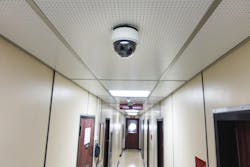How K-12 schools can maximize surveillance upgrades
K-12 schools are experiencing a disturbing uptick in violence and other serious security threats. They’re also feeling the pressure from stakeholders to find new and better ways to improve security.
Video surveillance has proven to be a strong defense in K-12’s security arsenal, but the reality is that many camera systems are becoming dangerously outdated. With public spending being squeezed, schools also have an added burden of building a solid business case to secure funding for upgrades that ensure value across the lifecycle of their video solutions.
The reality is, many K-12 administrators and security teams schools lack the financial resources, expertise, and experience to upgrade aging surveillance systems, especially when compared to universities and colleges.
This can leave them vulnerable to making mistakes, like paying too much for video management software, being stuck with needlessly high operating costs and missing opportunities to take advantage of the latest software tools and advances in AI video designed to keep students and staff safe and increase efficiency.
Systems integrators have a strong opportunity to step up and support their K-12 customers in addressing these issues and present new solutions that are perfectly targeted to their individual schools’ needs.
The ‘Essential Enabler’
Video is an essential enabler, giving security teams or outsourced monitoring companies the ability to detect threats at an early stage.
For example, if an intruder enters the school grounds by breaching a perimeter fence, video system monitoring allows faster detection of the potential threat, initiation of lockdown and other needed response procedures. And if the threat is not apparent at the perimeter, video monitoring will support faster detection throughout school facilities, including entrances, hallways, gymnasiums and communal areas.
In school settings, however, security planners need to balance a conducive learning environment with cameras that are effective yet unobtrusive, affordable to run and maintain, and easy to use.
The system design should consider that many K-12 school budgets don’t always have the luxury of having an IT department. In addition, security managers that work in K-12 are often too busy managing day-to-day operations to take time to evaluate in-house a complex surveillance market that continues to innovate at a rapid rate. To adequately address serious security needs and solutions for K-12 schools, a seasoned systems integrator or consultant is usually needed.
There’s no one-size-fits-all approach, but many of the same core protective principles apply to all schools: physical security systems must be designed to allow detection of threats and incidents, to delay incidents from occurring, and to respond quickly in a way that overcomes the threat or limits losses or damage.
1. Effective Cameras that Blend into the Learning Environment
Some important features to look for include high resolution, true wide dynamic range (WDR), IR, and motion detection and compression technologies to reduce storage cost. It's also important to choose cameras that are durable and weather-resistant to ensure they can withstand the outdoor elements.
And full site coverage doesn’t have to be unsightly. Today’s cameras don’t have to detract from the aesthetics of the learning environment. For example, robust yet unobtrusive dome and bullet cameras can be used internally and externally to capture images in UHD quality, even in challenging lighting conditions; multi-directional cameras can be an attractive option for corridors; while fisheye cameras can be used to provide wide-area coverage of communal spaces, providing excellent capture compared to three or four fixed lens cameras.
Student privacy is paramount so if schools are experiencing challenges in restrooms and locker rooms such as vaping or bullying, consider a field of view that doesn’t compromise privacy by placing cameras strategically and using privacy masking. At the same time, encourage schools to communicate with parents and students about the use of video surveillance and how it promotes safety and security in the school.
2. The Importance of NDAA Compliance
In 2019, the John S. McCain National Defense Authorization Act (NDAA) banned U.S. government agencies from purchasing any surveillance products manufactured by Dahua and Hikvision. The ban not only included the ‘name brand’ products from these companies but also all their OEM brands - in essence, companies that outsourced their manufacturing. The NDAA also banned products from Huawei, which is significant because Huawei’s HiSilicon chipsets are used in most older video surveillance cameras and recorders.
Further, NDAA compliance of surveillance systems is also covered by the Secure Equipment Act of 2021. This newer legislation prohibits the Federal Communications Commission (FCC) from reviewing or issuing new equipment authorizations for companies placed on its “Covered List” of organizations whose equipment is considered a threat to national security due to cybersecurity weaknesses.
If schools are still using older cameras and recorders with HiSilicon chipsets or Hikvision and Dahua equipment and it fails, the harder it will be to find cost-effective replacements, leading to downtime and gaps in security.
The challenge for K-12 schools is that non-compliant equipment is often hard to spot, as the banned companies supply multiple vendors that do not bear the banned brand names. Many K-12 schools also use systems integrators that may not be involved in federal government projects, meaning they may not have been compelled to fully understand the implications of the NDAA for the education sector.
Regardless, the regulations are far-reaching and encompass both new contracts and renewing or extending existing ones. They also prohibit federal loan or funding recipients, such as schools, from working with integrators and their subcontractors that market, sell, or install unlawful surveillance equipment.
Consequently, it’s imperative that schools work with knowledgeable and reputable systems integrators and adopt NDAA-compliant solutions if they already receive federal funding or plan to apply for loans. In addition, many stakeholders, including parents, are unlikely comfortable that Chinese cameras could be used to gather information on their local schools for malicious purposes. There is also the danger posed by cybersecurity vulnerabilities, which means video streams could be watched by bad actors for seedy purposes.
3. Ensuring A Low Total Cost of Ownership
Affordability is a key factor for schools, and systems integrators can build a compelling case around solution lifecycle costs, or total cost of ownership (TCO).
It’s important to explain to end-users that lower upfront equipment costs are often too good to be true. There’s also a raft of new vendors offering free cloud-based surveillance trials with the aim of tying schools into five or even ten year ongoing contracts.
Low quality video surveillance kits are likely to result in equipment failures and higher maintenance burdens, while cloud-based systems come with significantly higher operating costs than NVR-based systems. There are also the risks that schools could wind up paying for VMS features they never use; or ongoing license fees and device connection costs; eye watering costs for adopting AI-powered analytics functions, third party cameras and devices; or annual fees for every user of the system.
Avoiding the pitfalls of these potential risks dictates the need for surveillance solutions that give schools the option to add unlimited users without escalating costs. And, with a lot of personnel potentially needing to use the system, including teaching staff as well as security personnel, this really matters. So, it’s worth looking out for those often hidden ongoing fees that can soon mount up, which will help build a strong business case and demonstrate to stakeholders they not only have long-term value, but a future-proof system.
Ultimately, upgrading systems should be a smooth and inexpensive process, especially with devices such as encoders that allow new and existing equipment to be cost-effectively integrated. This reduces waste and allows a phased migration to an up-to-date solution that gives schools all the functions they need to enhance safety and security and save on costs.
4. Harnessing AI-Powered Analytics to Improve Vigilance
Recent innovations in AI-analytics and mobile apps can really benefit schools and take pressure off busy security officers and control room staff to increase operational efficiency.
One of the key advantages of analytics – which are now increasingly accurate, thanks to deep learning advances – is they automate tasks that were previously performed manually, such as monitoring and analyzing video footage, freeing up staff to focus on higher-level tasks.
Impressive performance when it comes to intrusion, line-cross detection, and loitering, means that selected points around schools can be watched over automatically and constantly, with warnings flagged-up when an event of potential interest occurs. And security staff no longer need to be in control rooms and receive alerts and notifications via mobile apps.
Adoption of AI can also help reduce the need for human monitoring, allowing schools to save on labor costs and reduce the chances of oversights, such as missing suspicious behavior particularly across busy campuses.
AI video is also making remote monitoring and virtual guarding a more cost effective and attractive proposition, as monitoring firms no longer need a multitude of staff to constantly monitor multiple video streams, allowing them to offer both a customized and far more competitively priced service.
In the past, analytics were often seen as costly or difficult to adopt, but today’s flexible product options give schools of all sizes the ability to deploy analytics to meet their specific needs, thanks to affordable edge AI cameras, easy add-on AI devices, or VMS video management software that comes with AI functionality without ongoing license fees.
For smaller schools, edge AI cameras or AI box devices will allow automated detection of unusual or suspicious behavior at specific risk points. For K-12 school districts, the best value choice for more than 32 cameras is likely a VMS that allows AI functionality to be scaled across their entire estate.
About the Author

Jason Burrows
Senior Sales Director
Jason Burrows is a Senior Sales Director at IDIS Americas, where he directs sales operations in North America. Burrows has been in the security industry for more than 30 years and has held key positions with the largest brands in video surveillance manufacturing and distribution.

